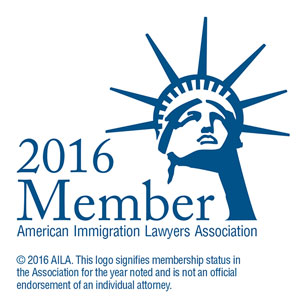Residence in the Twilight Zone: Are USCIS and the State Department Trying to Encourage Some U.S. Citizen Parents to Get Divorced?
Under section 301(c) of the Immigration and Nationality Act (INA), 8 U.S.C. § 1401(c), a child born outside the United States is a citizen when born “of parents both of whom are citizens of the United States and one of whom has had a residence in the United States or one of its outlying possessions, prior to the birth of such person.” Unlike some other provisions of the INA, no minimum required period of residence is specified.
Historically, this provision has been interpreted as applying whenever either parent had been present in the United States for any significant period of time, excluding only very brief presence in transit and the like. (I believe this was set out in former section 1133.5 of volume 7 of the State Department’s Foreign Affairs Manual, but have so far been able to find on the Internet Archive only a reference to the February 2016 guidance that first sought to exclude the sorts of less-brief but still non-permanent stays discussed further below.) This makes sense, because residence is defined in INA § 101(a)(33), as one’s “principal, actual dwelling place in fact, without regard to intent”, 8 U.S.C. § 1101(a)(33). Any time one dwells and sleeps in the United States for a period of time, whether this is days, weeks, or months, the dwelling place in the United States would seem to have become one’s residence under this definition for that period of time, since what distinguishes that dwelling place from any other more permanent residence one may have is primarily one’s intent to return abroad, and the definitional provision (as opposed to other parts of the INA) specifically deems intent irrelevant.
On August 28, 2019, however, USCIS issued new guidance in the form of a Policy Alert, PA-2019-05, effective October 29, 2019, which will update the USCIS Policy Manual to impose a stricter interpretation of “residence” for purposes of INA § 301(c) and other provisions of the INA which use the term. According to the new guidance in PA-2019-05, even spending two months at a time in the United States may not qualify as having ever had a “residence” there, if one lived outside the United States for the rest of the year and came to the United States to attend a summer camp or stay for a couple of weeks at a time with different relatives. There is a specific example given where “As a child, U.S. citizen parent came to the United States for 3 consecutive summers to attend a 2-month long camp. The parent lived and went to school in a foreign country for the rest of the year.” PA-2019-05 at 3. It is said that this parent did not show past residence in the United States to enable transmission of citizenship under INA 301(c).
This follows on the heels of similar guidance from the State Department, which amended the Foreign Affairs Manual, specifically 8 FAM 301.7-4(B) (last amended June 27, 2018), to describe residence as a “very fact-specific test” that “takes into account the nature and quality of the person’s connection to the place.” According to the current version of 8 FAM 301.7-4(B), “Department guidance clearly states that residence is more than a temporary presence and that visits to the United States are insufficient to establish residency for the purposes of citizenship transmission under INA 301(c).” 8 FAM 301.7-4(B)(h.) elaborates: “While the definition of residence is not dependent on a specific time period in the United States, the longer the duration of a person’s stay in a particular place in the United States (e.g., six months or more), the more likely it is that that place can be characterized as the person’s residence. On the other hand, if the stay at a place in the United States was relatively brief (e.g., a few months or less), then in order for that place to be considered a “residence” additional evidence may be required to show why the stay, though brief, was other than a temporary visit.” The U.S. District Court for the District of Columbia recently upheld some State Department findings of lack of citizenship under this policy in Chacoty v. Pompeo.
This stricter interpretation of INA § 301(c), however, has some truly bizarre implications when it is read in the context of the rules governing transmission of citizenship to children born to one U.S. citizen parent and one non-citizen parent, and the rules governing citizenship to children born out of wedlock. Counting periods of presence of “a few months or less” as not establishing residence even if repeated, as PA-2019-05 and the current version of 8 FAM 301.7-4(B) do, implies that certain U.S. citizen women who are contemplating giving birth to a child outside the United States ought to divorce their spouses, and leave them, in order to ensure that their children will be U.S. citizens. It also implies that certain U.S. citizens contemplating starting families outside the United States should reject some U.S. citizen spouses in favor of non-citizen spouses, again to ensure that their future children will be U.S. citizens.
To see why, we need to turn first to INA § 301(g), 8 U.S.C. § 1401(g), which confers U.S. citizenship at birth on
a person born outside the geographical limits of the United States and its outlying possessions of parents one of whom is an alien, and the other a citizen of the United States who, prior to the birth of such person, was physically present in the United States or its outlying possessions for a period or periods totaling not less than five years, at least two of which were after attaining the age of fourteen years: Provided, That any periods of honorable service in the Armed Forces of the United States, or periods of employment with the United States Government or with an international organization as that term is defined in section 288 of title 22 by such citizen parent, or any periods during which such citizen parent is physically present abroad as the dependent unmarried son or daughter and a member of the household of a person (A) honorably serving with the Armed Forces of the United States, or (B) employed by the United States Government or an international organization as defined in section 288 of title 22, may be included in order to satisfy the physical-presence requirement of this paragraph.
That is, when a U.S. citizen parent has a child with someone who is not a U.S. citizen or national (what the statute calls an “alien”, although some immigration lawyers try to avoid using a word that makes noncitizens sound like they are from another planet), the basic rule is that the U.S. citizen can transmit citizenship if he or she has been actually or constructively physically present in the United States for a total of five years, at least two of which are after the age of 14. This physical presence, even USCIS and the State Department recognize, is not limited to periods of time qualifying as “residence”; it covers any time spent in the United States (or spent abroad serving in the armed forces, or employed by the U.S. government or a qualifying international organization, or as the dependent unmarried son or daughter and household member of someone so serving or employed). Indeed, the chart on page 3 of PA-2019-05 specifically credits its hypothetical purportedly non-resident U.S. citizen parents with the amount of physical presence they had accrued during their trips to the United States.
The next piece of the puzzle is INA § 309(a), 8 U.S.C. § 1409(a), which describes the circumstances under which fathers of a child born out of wedlock are considered for purposes of transmission of U.S. citizenship. According to the statute:
The provisions of paragraphs (c), (d), (e), and (g) of section 1401 of this title, and of paragraph (2) of section 1408 of this title, shall apply as of the date of birth to a person born out of wedlock if-
(1) a blood relationship between the person and the father is established by clear and convincing evidence,
(2) the father had the nationality of the United States at the time of the person’s birth,
(3) the father (unless deceased) has agreed in writing to provide financial support for the person until the person reaches the age of 18 years, and
(4) while the person is under the age of 18 years-
(A) the person is legitimated under the law of the person’s residence or domicile,
(B) the father acknowledges paternity of ‘the person in writing under oath, or
(C) the paternity of the person is established by adjudication of a competent court.
Children born out-of-wedlock to U.S. citizen mothers were formerly treated differently under INA § 309(c), 8 U.S.C. § 1409(c), which required a single year of continuous physical presence in the United States by the mother, but the Supreme Court declared this different treatment of mothers and fathers unconstitutional in its June 12, 2017 decision in Sessions v. Morales-Santana, and prospectively struck it down for children born after the Court’s decision.
With these legal background rules in mind, consider the situation of a U.S. citizen prospective parent who was born abroad and grew up primarily in a foreign country, but has come to the United States for two months every year—to visit relatives, to attend summer camp as a child, to serve as a counselor at that same summer camp as an adult, and so on. By the time he or she is over age 30, he or she will have more than 60 months of combined physical presence, that is to say, five years, and more than two of those years of physical presence will have been after the age of 14. According to PA-2019-05 and the current version of 8 FAM 301.7-4(B), however, it appears that USCIS and the State Department will consider such a U.S. citizen never to have had a “residence” in the United States. The perverse effect of disregarding, as “residence”, periods of physical presence sufficiently substantial to add up to more than 5 years, is to leave such a U.S. citizen parent worse off under INA § 301(c) than under INA § 301(g), even though § 301(c) was apparently intended to be more lenient than §301(g).
Assume that such a U.S. citizen is contemplating marriage, and that one potential suitor is a U.S. citizen who does not meet the residence requirement (either because he or she has never been to the United States or because he or she fails the new stricter residence test), while another is not a U.S. citizen or national. A child born outside the United States to this purportedly “non-resident” U.S. citizen and another non-resident U.S. citizen will not be a U.S. citizen, under the PA-2019-05 / 8 FAM 301.7-4(B) interpretation of INA § 301(c). A child born in wedlock to this same U.S. citizen parent and a foreign parent, on the other hand, will be a U.S. citizen under INA § 301(g), because the U.S. citizen parent has accumulated at least five years of physical presence, at least two of which were after the age of 14. So it appears that USCIS and the Department of State would suggest, at least implicitly, that our hypothetical U.S. citizen parent should make sure to marry the foreign prospective spouse and not the non-resident U.S. citizen prospective spouse.
This is bizarre enough, but it gets worse. Assume that our hypothetical U.S. citizen prospective parent, with more than 60 months of physical presence accrued in two-month increments, is a woman who has already married a never-resident U.S. husband, presumably not having done the above analysis, and has become pregnant. She would like to give birth to her child outside the United States, perhaps because that is where more of her relatives live, but she would like the child to be a U.S. citizen. It appears that what she needs to do is divorce her U.S. citizen husband before the child is born, and make sure that the father does not take the steps prescribed by INA § 309(a), such as promising in writing to support the child as required by INA § 309(a)(3).
As a single parent, our hypothetical U.S. citizen mother presumably ought to again be subject to the rules of INA § 301(g), under which she qualifies to transmit citizenship. As the Supreme Court put it in Sessions v. Morales-Santana, the “five- year requirement should apply, prospectively, to children born to unwed U. S.-citizen mothers.” Morales-Santana, slip op. at 28. State Department guidance asks a consular officer encountering the situation of an out-of-wedlock child born to U.S. citizen parents after June 2017, where the father has not satisfied the requirements of INA § 309(a), to “please refer to AskPPTAdjudication@state.gov”, but it is difficult to see how that office could reject a claim valid under INA § 301(g) on the basis that the existence of the father, who could not be counted as relevant under the statute, should leave the mother and her child worse off than if the father was a non-citizen or was simply unknown (or was claimed to be unknown). Indeed, the Foreign Affairs Manual specifically states at 8 FAM 301.7-4(E)(3)(g.) that
An individual born abroad out of wedlock on or after June 12, 2017 to a U.S. citizen mother and alien father acquires U.S. citizenship at birth if the U.S. citizen mother has been physically present in the United States for five years, two of which are after the age of 14, prior to the child’s birth.
Regardless of what AskPPTAdjudication@state.gov would say if confronted with affirmative documentation of a known U.S. citizen father who did not satisfy INA § 309(a), it is difficult to picture an interrogation regarding the identity of the father followed by a denial of U.S. citizenship because the suspected father was thought to be a U.S. citizen himself.
Nor is this the end of the absurdities created by the current interpretation. There is the concept in immigration law of a sham divorce, if the parties to a former marriage do not actually separate but continue to reside together and have divorced only for immigration purposes, as described in Matter of Aldecoaotalora, 18 I&N Dec. 430 (BIA 1983). Such a divorce is not considered valid for immigration purposes. Thus, it appears that our hypothetical U.S. citizen mother should not merely divorce her husband, but also actually leave him, if she wishes to be able to transmit U.S. citizenship, lest her divorce be deemed a sham under Matter of Aldecoaotalora.
There is a certain amount of déjà vu in all of this for the author of this blog, who wrote a law journal article more than a decade ago that discussed a similar anomaly formerly applicable to a mother born in the United States who left after the age of one year and before the age of sixteen, due to the separate provision of INA § 309(c), 8 U.S.C. § 1409(c), for children born out of wedlock to U.S. citizen mothers. With its 2017 decision in Sessions v. Morales-Santana striking the separate rule of INA § 309(c) as unconstitutional, however, the Supreme Court has eliminated that anomaly for children born on or after June 12, 2017. USCIS and the State Department appear determined to create another one.
If the U.S. government does not really mean to be encouraging some prospective mothers to divorce and leave their husbands, and encouraging other prospective U.S. citizen parents to make sure to marry foreigners rather than U.S. citizens, it should reconsider the guidance contained in as PA-2019-05 and the current version of 8 FAM 301.7-4(B), and return to the earlier, more liberal construction of “residence”. Indeed, the bizarre result produced by the current guidance suggest that it may be incompatible with the legislative intent behind the statute, since one doubts that the Congresses that enacted the relevant sections of the INA intended to encourage divorce or the favoring of foreign spouses over U.S. citizen spouses. Courts adjudicating future litigation regarding INA § 301(c), and lawyers litigating cases regarding INA § 301(c), would be well advised to consider this.




